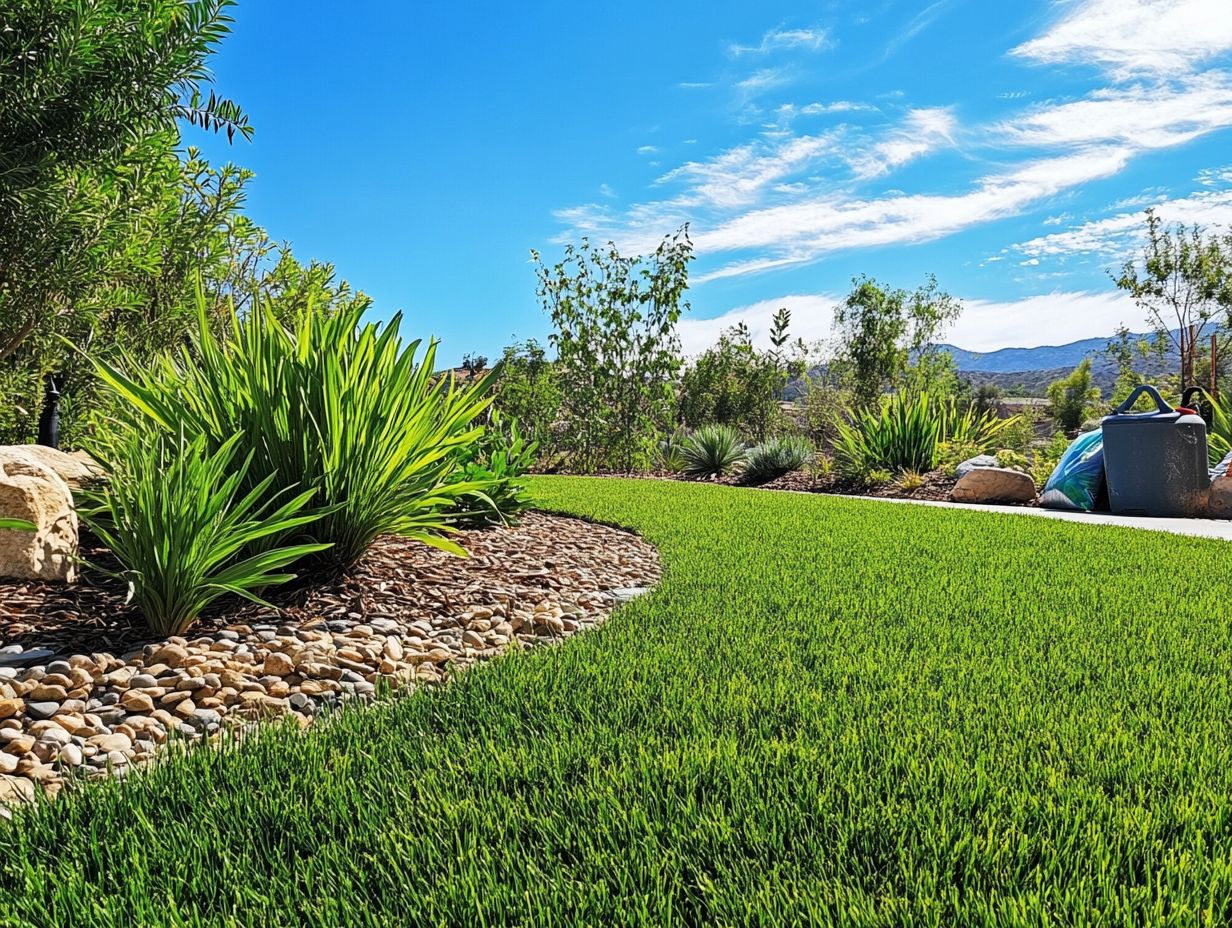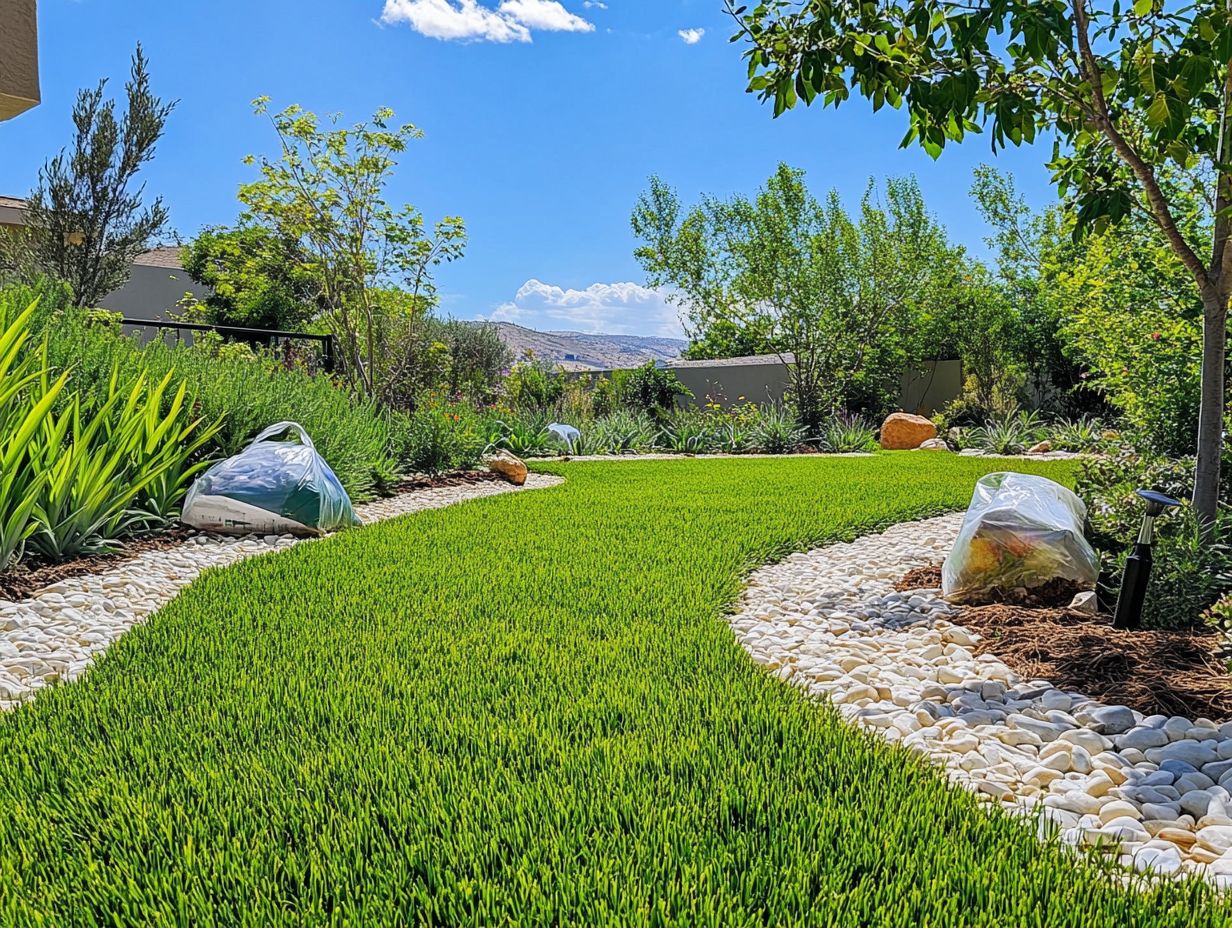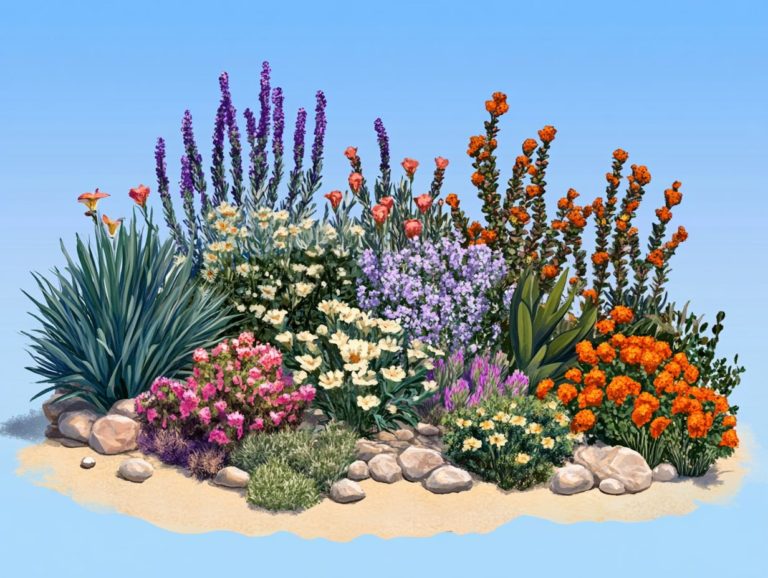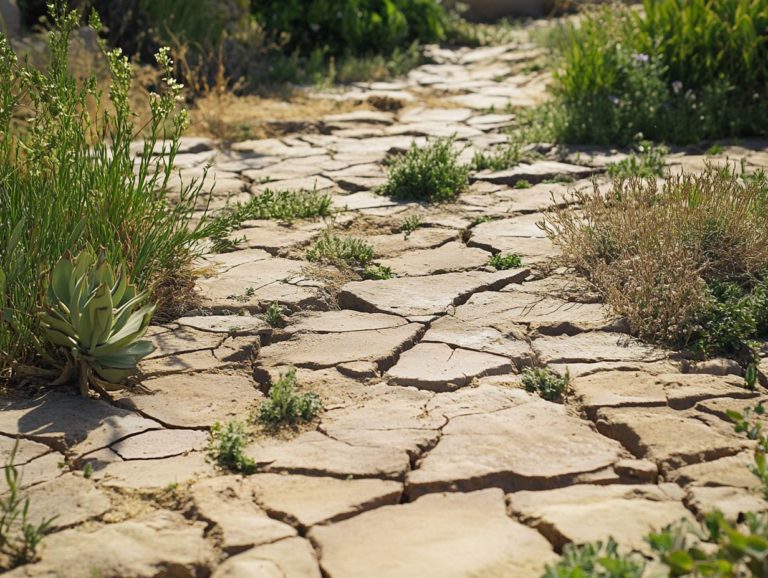How to Create a Drought-Resistant Lawn
Drought presents considerable challenges for achieving a lush, healthy lawn. It often results in unsightly brown patches and stressed plants.
Understanding how drought impacts your lawn is essential for effective management. This guide will help you select the right drought-resistant grass types, prepare your soil, and implement efficient watering techniques.
You will also find vital maintenance tips and explore alternative landscaping ideas that aid in water conservation.
Immerse yourself in this guide to cultivate a vibrant, resilient lawn even in dry conditions!
Contents
- Key Takeaways:
- Understanding Drought and Its Effects on Lawns
- Choosing the Right Grass for a Drought-Resistant Lawn
- Preparing Your Lawn for Drought
- Watering Techniques for a Drought-Resistant Lawn
- Maintaining a Drought-Resistant Lawn
- Other Ways to Conserve Water in Your Lawn
- Frequently Asked Questions
- What are some tips for creating a drought-resistant lawn?
- What type of grass should I choose for a drought-resistant lawn?
- How often should I water my drought-resistant lawn?
- Can I use native plants in my drought-resistant lawn?
- What are some drought-resistant landscaping techniques?
- Why is it important to create a drought-resistant lawn?
Key Takeaways:

- Choose the right type of grass that thrives in drought conditions to create a drought-resistant lawn.
- Proper soil preparation and maintenance are crucial for your lawn during a drought.
- Effective watering strategies and regular maintenance are key to maintaining a drought-resistant lawn, along with alternative landscaping ideas to conserve water.
Understanding Drought and Its Effects on Lawns
Drought refers to an extended period marked by abnormally low rainfall, which can have a big impact on the health and aesthetics of lawns in areas like California, Texas, and Arizona.
As water scarcity intensifies due to climate change, you face the challenge of embracing sustainable landscaping practices that enhance soil moisture retention and bolster your lawn’s resilience.
It s essential to grasp how drought influences lawn health if you aim to maintain a stunning outdoor space while prioritizing water conservation and implementing effective irrigation techniques.
What is Drought and How Does it Affect Lawns?
Drought can place significant stress on your lawn, leading to issues such as browning, wilting, and an overall decline in health.
As the sun relentlessly beats down, you may notice various types of grass like Kentucky bluegrass or fescue showing signs of dehydration, with patches of brown and difficulty recovering from foot traffic. Perennial plants aren’t spared either; they might exhibit drooping leaves and a compromised root system, which could ultimately lead to their demise if the lack of water continues.
To combat these adverse effects, consider adopting practices like deep watering during the cooler parts of the day to help maintain soil moisture. Applying mulch (a protective layer of material) around plant bases can also be beneficial, as it reduces evaporation and provides a protective layer that alleviates stress during sweltering summer months.
Choosing the Right Grass for a Drought-Resistant Lawn
Choosing the right grass is crucial for establishing a drought-resistant lawn that flourishes even in tough conditions. Different grass varieties, such as Bermuda grass and Buffalo grass, showcase impressive drought tolerance and can thrive with limited water availability, making them perfect for areas like New Mexico and the Florida Keys.
By focusing on native plants that have adapted to survive in harsher climates, you can create a sustainable landscape that reduces water consumption while enhancing its visual charm.
Types of Grass That Thrive in Drought Conditions
Several types of grass excel in drought conditions, such as Bermuda grass and Buffalo grass. Understanding the unique characteristics of these grasses is essential if you aim to cultivate a resilient lawn.
Bermuda grass thrives in full sunlight and prefers well-drained soils, making it a perfect choice for warmer regions. This hardy grass not only withstands heat but also requires less irrigation once established, allowing you to enjoy a vibrant lawn with minimal maintenance.
Conversely, Buffalo grass is an excellent option for those living in cooler climates, as it boasts impressive drought resistance and can flourish in various soil types.
To maintain optimal growth for both, engage in regular mowing, proper fertilization, and mulching. These practices significantly enhance their overall health and ability to endure dry spells. By implementing smart lawn care techniques, you can cultivate a lush and sustainable landscape even when faced with challenging weather conditions.
Start transforming your lawn today for a greener tomorrow!
Preparing Your Lawn for Drought

Preparing your lawn for drought requires meticulous soil preparation and the strategic application of organic mulch. These practices optimize moisture retention. Additionally, learning how to create a wildlife-friendly drought garden fosters a deep root system, allowing your grass to access water more effectively, enabling it to flourish even in water scarcity.
This foundational strategy bolsters your lawn’s health and aligns with sustainable landscaping principles that promote ecological balance and conserve resources.
Proper Soil Preparation and Maintenance
Proper soil preparation is essential for establishing a robust lawn that can endure drought conditions.
Effective soil preparation involves several necessary steps:
- Conduct a soil test: This check helps you understand what your soil needs to grow well.
- Enrich the soil: Adding organic matter like compost or well-rotted manure improves its structure and water retention.
- Maintain soil health: Incorporate mulching techniques to help retain moisture and reduce evaporation.
- Select drought-resistant grass varieties: This choice further enhances your lawn s long-term resilience.
Watering Techniques for a Drought-Resistant Lawn
Efficient irrigation techniques are essential for cultivating a drought-resistant lawn, especially in water-scarce regions like Nevada and Arizona.
Conduct a thorough water audit to evaluate your current watering practices. Make necessary adjustments to optimize water usage so that every drop works toward the vitality of your lawn.
Techniques such as deep watering are effective. This practice promotes a strong root system crucial for enduring drought conditions.
Effective Watering Strategies and Tools
Effective watering strategies are essential for a thriving drought-resistant lawn, especially when you learn how to plan a drought-resistant garden layout using specialized tools and techniques.
Integrate advanced irrigation systems like drip irrigation and soaker hoses to boost water efficiency. These tools deliver moisture directly to the roots of your plants, minimizing evaporation and runoff.
Make sure to adopt smart irrigation systems that leverage weather data to fine-tune your watering schedules. This ensures your plants receive just the right amount of water at the ideal time.
Keep an eye on soil moisture levels through sensors or probes. This practice helps adjust your watering approach, avoiding the pitfalls of under and over-watering.
Implementing these strategies not only conserves precious water resources but also fosters healthier plant growth while reducing your maintenance efforts.
Maintaining a Drought-Resistant Lawn
Maintaining a drought-resistant lawn demands consistent care and a keen eye for detail. To enhance your efforts, learn how to design a drought-tolerant garden and emphasize regular maintenance practices to boost drought tolerance.
Assess the health of your lawn and tackle common issues head-on. Adopt a proactive approach incorporating effective troubleshooting tips.
This strategy prevents more significant problems in the future, ensuring your landscaping remains sustainable and visually appealing, even when faced with challenging conditions.
Start preparing your lawn today to ensure it thrives through the next drought!
Regular Maintenance and Troubleshooting Tips

Regular maintenance is essential for cultivating a drought-resistant lawn. This ensures it remains healthy and resilient against stress from the environment.
By adopting thoughtful practices like appropriate mowing heights and efficient irrigation schedules, you can significantly enhance the durability of your turf. Mowing at a higher setting enables your grass to develop deeper roots, allowing it to access moisture more effectively.
Implementing a watering strategy that prioritizes early morning hours minimizes evaporation and maximizes absorption. Should pests invade your sanctuary, early identification and organic treatment options can mitigate damage without compromising your lawn s drought-resistant qualities.
Other Ways to Conserve Water in Your Lawn
Along with choosing drought-resistant plants and grasses, you have many options for conserving water in your lawn. Consider exploring alternative landscaping techniques and applying xeriscaping principles, a method that conserves water by using drought-resistant plants.
These approaches minimize water usage and enhance the sustainability of your landscape, especially in arid regions such as Texas and New Mexico. By embracing these practices, you can cultivate a stunning, eco-friendly outdoor space that flourishes even in challenging conditions.
Alternative Landscaping Ideas and Practices
Alternative landscaping practices, like xeriscaping, can dramatically boost your water conservation efforts in drought-prone areas. By focusing on native plants and efficient irrigation systems, you can create stunning gardens that thrive with minimal water.
For example, integrating rock gardens not only reduces water usage but also introduces unique textures and vibrant colors to your landscape. Opting for permeable paving materials allows rainwater to seep into the ground, replenishing local aquifers and reducing runoff.
These sustainable landscaping choices create a healthier environment and encourage biodiversity. By emphasizing these practices, you re making a meaningful contribution to both your aesthetic vision and environmental sustainability.
Frequently Asked Questions
What are some tips for creating a drought-resistant lawn?
Some tips for creating a drought-resistant lawn include choosing the right type of grass, watering deeply and infrequently, using native plants, and incorporating drought-resistant landscaping techniques such as mulching and rainwater harvesting.
What type of grass should I choose for a drought-resistant lawn?

When choosing grass for a drought-resistant lawn, look for varieties with deep root systems, such as Bermuda grass, buffalo grass, or zoysia grass. These types can better withstand drought periods and require less water to maintain their health. For more tips, check out this guide on how to maintain drought-resistant landscapes.
How often should I water my drought-resistant lawn?
For a drought-resistant lawn, it is best to water deeply and infrequently. To learn more about effective methods, check out this guide on how to incorporate drought-resistant plants. Water your lawn once or twice a week, giving it a thorough soaking to encourage deeper root growth.
Can I use native plants in my drought-resistant lawn?
Yes, incorporating native plants into your drought-resistant lawn is a great way to reduce water usage. Native plants are adapted to the local climate and require less water to thrive, attracting beneficial insects and wildlife.
What are some drought-resistant landscaping techniques?
Some drought-resistant landscaping techniques include mulching, which helps retain moisture in the soil, and using rainwater harvesting systems. Additionally, learning how to create a drought-tolerant garden through xeriscaping, which involves using plants that require minimal water, is also a popular technique for developing a drought-resistant lawn.
Start implementing these tips today for a beautiful, drought-resistant lawn!
Why is it important to create a drought-resistant lawn?
Creating a drought-resistant lawn helps conserve water, which is especially crucial in areas prone to drought. For effective strategies, consider how to design a drought-tolerant landscape.
A drought-resistant lawn saves you time and money on maintenance. Transform your yard today into a beautiful landscape by learning how to get started with drought-resistant gardening that saves you both time and money!






